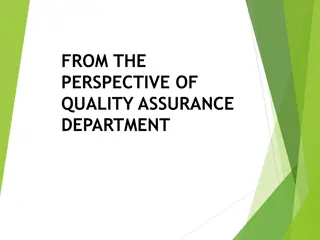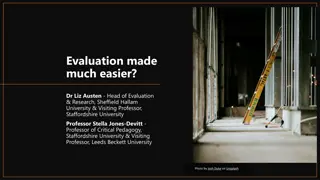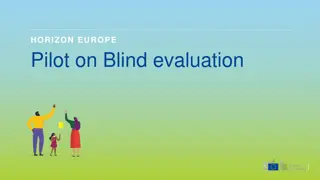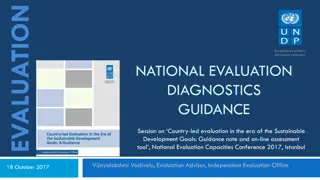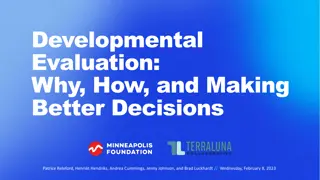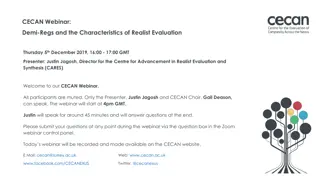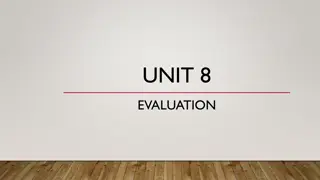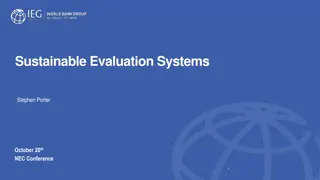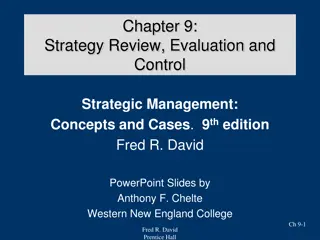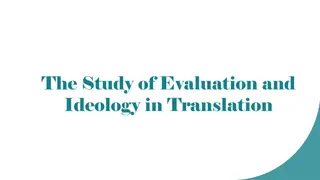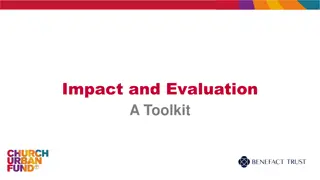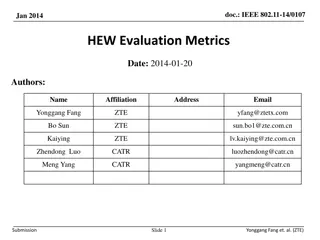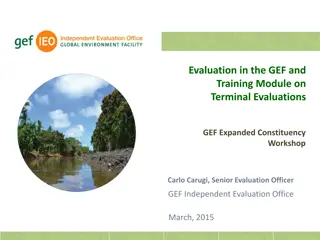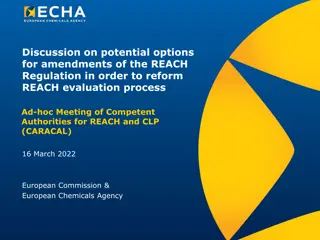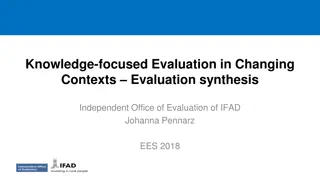“The P. and P. Evaluation”
The P and P Evaluation focusing on substance abuse referral issues, psychiatric diagnoses, substance dependence characteristics, course of illness, and FAA regulations. Learn about common referral issues, medically disqualifying psychiatric diagnoses, and the course of substance dependence. Understand the stages of substance dependence, assessment criteria, and implications for social, personal, and occupational functioning. Gain insights into the impact on physical health, legal issues, and familial relationships. Discover the importance of early intervention and treatment in managing substance dependence effectively.
Download Presentation

Please find below an Image/Link to download the presentation.
The content on the website is provided AS IS for your information and personal use only. It may not be sold, licensed, or shared on other websites without obtaining consent from the author.If you encounter any issues during the download, it is possible that the publisher has removed the file from their server.
You are allowed to download the files provided on this website for personal or commercial use, subject to the condition that they are used lawfully. All files are the property of their respective owners.
The content on the website is provided AS IS for your information and personal use only. It may not be sold, licensed, or shared on other websites without obtaining consent from the author.
E N D
Presentation Transcript
The P. and P. Evaluation (With an Emphasis on the first P ) William E. Win Green, III, MD, DFAPA, FASAM williamegreeniiimd@gmail.com 9/26/2021
Four Common Referral Issues Assessment for Substance Abuse/ Dependence (Ex.- after DUI/ DWI) Post- treatment- psychiatric part of P&P. Depression/ Anxiety Disorders- on or off SSRI medication. Behavioral Issues or Fitness for Duty - is there a severe personality disorder or psychiatric disorder?
Psychiatric Diagnoses: Medically Disqualifying In F.A.R. s Psychosis Bipolar Disorder Personality Disorder severe enough to have manifested itself by repeated overt acts Substance Dependence, UNLESS satisfactory evidence of total (documented) abstinence for NO less than TWO years.
Substance Dependence (addiction) Characteristics Loss of Control Compulsive Use Continued Use in spite of Consequences -(3 C s) Characteristic Symptoms- Family Discord & Problems, Tolerance, Blackouts, Legal Issues (DUI/ DWI, Public. Intox.), Excessive Sick Leave, Irritability, physical effects (heart, BP, liver, neurologic, etc.), seizures, withdrawal symptoms, withdrawal delirium, failure to fulfill expected roles, positive DOT or workplace test, variable performance, etc.
Course of Illness EARLY - episodic loss of control, occasional consequences, FAMILY ISSUES! (divorce, etc.), tolerance, blackouts, legal issues, job loss, etc. MIDDLE - increasingly frequent loss of control, begin to see physical withdrawals, medical complications, further consequences. LATE - Worsening medical issues, neurological & cognitive impairment, cirrhosis/ liver failure, Cardiomyopathy, alcohol associated dementia (irreversible), Withdrawal seizures, etc. 4thstage= Too Late - death/ jails/ institutions
Substance Dependence (per CFR 67.107) Substance Dependence (as far as the FAA goes) ONLY requires ONE or more of the following: Tolerance (DUI/ DWI with BAC > 0.149%) Withdrawal Symptoms Impaired Control of Use Continued Use (or return to use) despite damage to physical health or impairment of social/ personal/ occupational function.
Substance Dependence/ Abuse (per CFR 67.107) Two other Situations CAN lead-> diagnosis. 1. Use of a substance in physically hazardous situation (DUI/ DWI, P.I., etc.) if there has EVER been another episode (arrest, etc.) of hazardous use. (Substance Abuse at a minimum) 2. Positive DOT test- (BAC 0.04 or higher) or positive drug test (Substance Abuse at a minimum). So it is pretty easy to fit criteria as per the FAA!
Must Haves for the Initial Appointment Inpatient record/ discharge summary/ labs/ physical exam, Arrests/ court records/ disciplinary reports, etc. Past treatment records, any medications, hospitalizations, Neuropsych. testing, etc. Any communications with the FAA or employer. Meeting attendance logs- AA/ aftercare/ B.O.A.F. meetings. Aftercare, peer pilot, and management reports. Reports from ANY other treatment providers. If in doubt, bring it or have it sent! We WILL also need the FAA MEDICAL FILE to be sent to us, ESPECIALLY if issues with FAA (revocation, DUI, repeat entry into HIMS program, etc.)
Components of Report Identifying Information- Name, age, marital status, consent, confidentiality issues, referral source, company/ position, etc. History of Present Illness- details of incidents -> treatment, arrest reports, DUI/ DWI, COMPREHENSIVE substance history (chronological), past treatment experiences, compulsive behaviors- especially if related to substance use (sex, gambling, etc.) consequences of use, as well as airman's AWARENESS of the consequences/ disease.
Components of Report- cont. History of Present Illness- continued - Treatment History/ Records- progress, difficulties, etc. - Post Treatment Experience- Recovery activity- AA/ NA/ CA, 90 in 90?, Home Group?, sponsor?, Step Work? - Acceptance of Disease? ( versus Compliance with monitoring) I typically end this section with fits criteria as evidenced by
Components- cont. Past Psychiatric/ Substance Abuse history Past Medical History, Medications, OTC medications, allergies? Family History- substance & psychiatric. Social/ Developmental history- Childhood, family, school, education, relationships, hobbies/ interests, marriage/ children, trauma or abuse history, etc.
Mental Status Exam Alert, oriented, dress, behavior, speech/ language Mood and Affect, Vegetative Symptoms? Thought Form- logical/ goal directed??? Thought Content- Any hallucinations/ delusions, SI, HI, paranoia ??? Memory/ Cognitive Functioning??? Any evidence cognitive dysfunction?
Report- Diagnosis Diagnosis- Will be as per the C.F.R. Part 67.107. Diagnosis is based on Federal Air Regulations, NOT on the DSM V (our current psychiatric manual). I typically include DSM V diagnosis. Interestingly DSM V did away with abuse as diagnosis, now looks at disease as a SPECTRUM - Mild, Moderate, Severe.
Diagnostic Criteria- Differences Substance Dependence Substance Use Disorders CFR Title 14 Part 67.107- (1 or more required) Increased tolerance Withdrawal symptoms Impaired Control of Use DSM 5 Textbook-at least 2-3 Increased Tolerance Withdrawal Symptoms Consume more than intended, unable cut down, cravings/ urges, time spent recovering Continued use despite persistent physical/ psychiatric problems, use when physically hazardous, failure to meet important social/ occupational/ recreational activities, etc. Continued Use despite damage to physical health, impaired social/ personal/ occupational function
Discussion/ Recommendations Overall summary of individual- reason for referral, circumstances, diagnosis/ issues, recommendations (or NOT recommend due to ) Example- John Doe is a 49 year old DWM with a long history binge drinking, led to breakup marriage, excessive sick time, eventually had a DUI with elevated BAC -> referral. Recommend- Complete Abstinence, Treatment, 12 step meetings (AA/NA), IOP/ aftercare after primary treatment, AA sponsor, union & management sponsors, follow-up, any special issues (individual therapy, marital therapy, etc.)
When is the Pilot READY for the Psychiatric & Psychological Evaluation? Primary Treatment is done, finished IOP and established in aftercare (best). Home situation stable, AA home group, sponsor, comfortable in aftercare group. Minimum 90 days after treatment! (120 days better!) Many pilots, with heavy alcohol/ sedative hypnotic use will flunk the neuropsychological tests if tested too early. Then they may need 6- 12 months (or more) clean time. Finished Fifth Step w/ sponsor!!!. Acceptance of disease concept!!!
https://encrypted-tbn0.gstatic.com/images?q=tbn:ANd9GcRFqbhCjuK-mMQH6INbzGPsGLK7163qua0xFT0Q0tBAMAO3dW3wVwhttps://encrypted-tbn0.gstatic.com/images?q=tbn:ANd9GcRFqbhCjuK-mMQH6INbzGPsGLK7163qua0xFT0Q0tBAMAO3dW3wVw
Monitoring the pilot in Recovery AA meeting attendance- VERY IMPORTANT! MINIMUM of 1/ week, in addition to aftercare! I always push them to go to 4 meetings/ week Sponsorship is highly correlated with sobriety. Acceptance (vs. Compliance with monitoring)!!! Do they FULLY believe the first step???- powerless over alcohol, life unmanageable All the other steps are goals that we are trying to achieve, but we HAVE to accept Step One completely!!!
Monitoring- cont. Work situation- return to work/ Special Issuance, stressors, cravings/ urges, able to make meetings?, any problems? Home situation- relationship/ S.O., family, children, financial situation, free time/ hobbies, Social Life- how are they handling it? Overnights??? How are they handling it? Specific Stressors- spouse drinking?, legal, separation/ divorce, affairs, financial, children, etc. Ideally I would like to see/ talk with the spouse!
Stages of Recovery 1. Containment- safe environment, contain the addiction/ behaviors, (hospital/ PHP/ IOP) 2. Early Cognitive Insight- begin to (occasionally) see behaviors as dangerous & harmful . Pilot often still sees recovery as a checklist to get back to work . 3. Emotional Integration- painful place in recovery where one reviews the past, experiences feelings, beginning to take responsibility for own behaviors. (Steps 4 & 5)
Recovery Stages- cont. 4. Transformational Experience- spiritual awakening , sometime comes quickly ( burning bush ), other times can take many years to develop- very slow gradual process. They accept that they have the disease, must work a good program to have good quality of life & meaning in their life. Sober because they truly want to be, not because they have to be . This can take a LONG TIME (often 3- 5 years or more) to develop!
My Views of Addiction Primary Illness- we drink too much because we re alcoholic- heavy genetic predisposition . Complete Abstinence is essential! Recovery-> much more than just not drinking . Recovery (12 Steps) give us tools to live life on life s terms, adapt, grow as human beings. We are either growing in recovery or sliding towards relapse, you can t coast forever . Old AA saying- Once a pickle, you can NEVER go back to a cucumber . Once you cross invisible line - can never return to drinking safely .
Ways to fail Your Initial (or Follow Up) Evaluations LIE! Sooner or later, We ll catch the lies . Forget to tell me about another DUI arrest, even when I ask any other arrests for anything in your entire life? Don t know the fundamentals of the 12 steps & have a poor working knowledge of basic recovery concepts. Don t provide all the information, especially if you try to cover something up. Can t remember the last time you went to a meeting, or called your sponsor, etc.
Goal of Psychiatric Evaluation We are looking at Airmen from a RECOVERY (and Psychiatric) standpoint, NOT their flying ability . Generally if they were able to fly safely before, while actively drinking, they are MUCH SAFER after they become sober. The reason people fail is they RELAPSE, not because of their aviation abilities . Try to intervene BEFORE a relapse occurs!!!
New Step Down Process Fall 2020, FAA came out with a new step down process. Lifetime special issuance , (not released) MUST use HIMS AME. As the pilot progresses in sobriety, monitoring gradually declines. The following are MINIMUMS .
Year One Weekly Aftercare Annual Psychiatric evaluation Twice weekly AA/ NA meetings (minimum) HIMS AME every 3 months CP Monthly, Peer pilot monthly (weekly?) UDS/ Alcohol tests minimum 14 per year
Early Phase (Years 2-4) Random testing at least 14 times/ year. Aftercare twice a month (can be released by AME) AA/ NA twice a week. CP, peer pilot meetings monthly HIMS AME every three months Can be released by HIMS psychiatrist from further evaluations.
Advanced Phase (Years 5-7) HIMS AME every 6 months Random UDS/ PEth tests minimum 4 per year. Weekly peer support (AA/ NA) Must continue to use HIMS AME
The End! Questions?






